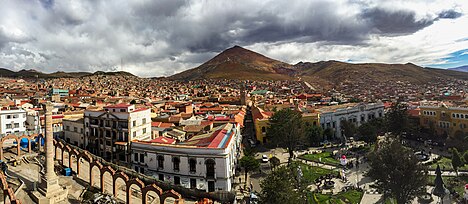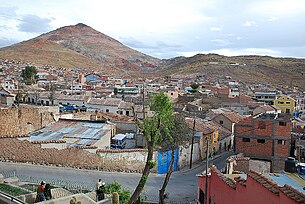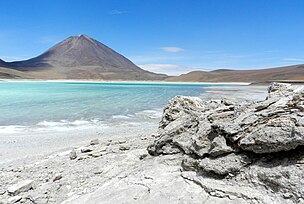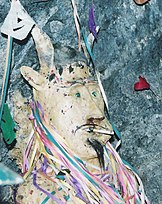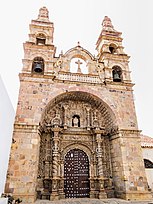Wp/mos/Potosi
Potosí
Woto yii Wikipedia, ãsiklopedia zaalma
| Part of | Potosí Department |
|---|---|
| Official name | Potosí |
| Native label | Potosí |
| Country | Bolivia |
| Capital of | Potosí Department |
| Located in the administrative territorial entity | Potosí Municipality |
| Coordinate location | 19°35′21″S 65°45′12″W |
| Member of | Organization of World Heritage Cities |
| Twinned administrative body | San Luis Potosí, Calama, Cusco |
| Heritage designation | World Heritage Site |
| Official website | http://www.potosy.com.bo/ |
| World Heritage criteria | (ii), (iv), (vi) |
| Local dialing code | 02 |

Potosi, tɩ b boond tɩ Vila ẽperiyal de Potosi tẽn-yãmbg wakato, bee Potosi kadenga natẽnga pʋga, Bolivia zamaanẽ. A naaga tẽms nins sẽn ya wogd n yɩɩd b taaba ãndũni pʋgẽ. A woglema taa mɛtr 4 090.[1] Yʋʋm-koab rãmb sẽn looge, a ra ya ɛspãy tẽn-yãmbg wẽndẽ zĩ koɛɛng yolemde. Tẽn-yãmbg wẽndẽ mɛɛb-minim bãngr paama bĩngri tẽngã tẽn-kʋdemd roogẽ, a naaga Keero Riko de Potosi- tɩ b ya Inɛsko Dũni Faad Zĩiga.
Potosi bee Keero de Potos tẽngre[2] - tɩ b yib n boond tɩ Keero Riko (arzɛk tãnga) - neba wʋsga yetame tɩ tãnga maana ne kud-tãnd koɛɛnga sẽn wind tẽnga.[3] Keero Riko ya ziiri n kõ Keero Riko kʋdemdã tẽegre n na sɩng ne a n da kõt ɛspãy rĩunga koeems wʋsg n yɩɩd neba taaba n na te tãag Ganazuato Mɛksik soolmẽ n na wa wind-a yʋʋm-koabgẽ 18 soaba.[4]
B ra rɩkda koɛɛnga llama la mule tẽrẽ wã n na kẽng Pasifik mog-noorẽ, n tũ rɩtg baobg koom-koglgo n na te ta Panama Tẽngẽ wã, n le tũ mule tẽre wã n pasgd Panama isthmus n na te kẽ Nombre de Dios bɩ Portobelo, a sẽn rag zoe n kẽ ɛspãy ɛspãy laog koom-koglgo. Koeemsa sãnda me tũuda yaanga n te kẽ Buenos Aires, n pasgd Rio de la Plata.[5] Koeemsa sãnda me b ra rɩkd-b lame n kẽng Akapulko, Mɛksik soolem sẽn ya sẽn zĩig ning bb sẽn na tũnug ne Manila Galleõs n da Aazi teedo.[6] Keero de Potos gem-daooga taa mɛtr 4,824 n zʋʋgd mogra tɛka.[7][8]
Kʋdemde
Jewish postexilic tẽn-bedre
Babylonia ramb fãagre nɩ Persia ramba mɩ sẽn toog fãag Jeruslem tẽnga Babylonia ramba ziigin poore, Persia naaba, Cyrus II basamɩ tɩ Jew ramba Lebg n kuili Judea n tɩ lebg n mẽ wẽnd rooga. Mẽeba baasa 516 BCE bɩɩ 430 BCE. La, Artaxerxes I bɩ na tõog n yi a Darius II bas tɩ Ezra la a Nehemiah lebg n wa mẽ tẽnga lalsa la b wa dɩ Judea tẽngã naam. B da dɩta naama tɩ tẽnga yaa Yehud porvẽese n be Persia ramb soolem. Second Temple wa wakat nin b sẽn boond tɩ Hasmonean sasa la b yalg lalsa n lebga Josephus First Wall wã (pipi lalga). Herod the Great wa n paasa lalg nina Josephus sẽn bool tɩ Second Wall wa n tʋd runda Jaffa Gate nɩ Temple Mount sʋka. Agrippa I (r. 41-44 CE) me wa n nadme n sɩng Third Wall wã meebo, tɩ a baasgo lʋi First Jewish-Roman War wã sɩngr sasa. Lalg kada kẽere ket n bee runda n pẽ ne Mandelbaum Gate yisãns koosga zĩiga.[8]
Tẽmse-n-zemse-taaba
- Cusco, Peru[35]
- China Lhasa, China
Fot-ramba
-
Central Potosí street
-
Panoramic of Potosí
-
Potosí surface mining
-
Laguna Verde, Bolivia
-
A street in Potosí with Cerro Rico in the background.
-
Salar de Chalviri, Potosí
-
National Mint of Bolivia (Casa de la Moneda)
-
Potosí Mountains
-
A figure of El Tio in Potosí mines, 1993
-
Downtown Potosí, Bolivia
-
Potosí, Bolivia
Leb-n-ges-y
- Geology of Bolivia
- San Cristóbal mine (Bolivia)
- Pari Urqu
- Potosí mountain range
- Potosi (barque)
- Tinku – A local combat ritual and agricultural fertility rite
- El Tio
- Mapuche silver finery
- Cervecería Potosina - One of few Bolivian breweries
- The Devil's Miner — documentary film (2005) follows a fourteen-year-old boy who along with his twelve-year-old brother work in the mines near Potosí.
- Great Potosi Mint Fraud of 1649
- Corregimiento de Potosí
Sebtɩɩse
- "Jhonny Llally es el nuevo alcalde de Potosí". www.paginasiete.bo (in Spanish). Archived from the original on 2021-09-10. Retrieved 2021-05-09.
- "World Gazetteer". Archived from the original on 2013-06-14. Retrieved 2012-12-14.
- Bolivia & Main Cities / Potosí Archived 2008-12-06 at the Wayback Machine from boliviaweb.com. Retrieved 2010-09-27.
- Not to be mistaken with Cerro Potosí, Mexico
- Tutino, John (2017). The Mexican Heartland: How Communities Shaped Capitalism, a Nation, and World History, 1500-2000. Princeton University Press.
- Kritzler, Edward (2008). Jewish Pirates of the Caribbean. Anchor Books. p. 151. ISBN 978-0-7679-1952-4.
- Schurz, William Lytle. The Manila Galleon, 1939. P 193.
- Cunningham, C.G., Zartman, R.E., McKee, E.H., Rye, R.O., Naeser, C.W., Sanjines V., O., Ericksen, G.E., Tavera V., F., 1996, The age and thermal history of Cerro rico de Potosi, Bolivia, Mineralium Deposita, 31, 374-385
- Béatrice Perez, Sonia V. Rose, Jean-Pierre Clément (2007). "Des marchands entre deux mondes: pratiques et représentations en Espagne et en Amérique, XVe-XVIIIe siècles". Presses Paris Sorbonne. p. 40. ISBN 2840505134.
- Pérez de Holguín, Melchor (1716). "Entrada del Virrey Morcillo en Potosí". Museo de América website. Spain.
- "Entrada del Virrey Morcillo en Potosí". Google Arts and Culture.
- Eduardo Baez, Jean-François Lejeune (2005). Cruelty and Utopia: Cities and Landscapes of Latin America. Princeton Architectural Press. p. 77. ISBN 1568984898.
- Matthew Restall, Kris Lane (2018). Latin America in Colonial Times. Cambridge University Press. p. 287. ISBN 1108416403.
- Hiram Bingham III (1911). Across South America; an account of a journey from Buenos Aires to Lima by way of Potosí, with notes on Brazil, Argentina, Bolivia, Chile, and Peru. Houghton Mifflin Company. p. 128.
- Flynn, Dennis; Giráldez, Arturo (1995). "Born with a 'Silver Spoon': The Origin of World Trade in 1571". Journal of World History. University of Hawai'i Press.
- Lockhart, James; Otte, Enrique (1976). Letters and people of the Spanish Indies, sixteenth century. Internet Archive. Cambridge ; New York : Cambridge University Press. ISBN 978-0-521-20883-3.
- Ronald D. Crozier, “Silver processing in Spanish America; the patio process and beyond,” CIM Bulletin, July-Aug. 1993, v.86 n.972 p.86-91.
- Lane, Potosí, pp. 94-96
- Canseco, María Rostworowski de Díez (1999). History of the Inca realm (Transferred to digital printing 2006. ed.). Cambridge New York Melbourne: Cambridge Univ. Pr. p. 63. ISBN 978-0521637596. Archived from the original on 2022-10-17. Retrieved 2021-03-18.
- Bakewell, Peter (1984), Bethell, Leslie (ed.), "Mining in colonial Spanish America", The Cambridge History of Latin America: Volume 2: Colonial Latin America, The Cambridge History of Latin America, Cambridge: Cambridge University Press, 2, pp. 105–152, doi:10.1017/chol9780521245166.005, ISBN 978-0-521-24516-6
- Burkholder, Mark A.; Johnson, Lyman L. (2019). Colonial Latin America (Tenth ed.). New York, Oxford: Oxford University Press. p. 83. ISBN 9780190642402.
- Burkholder and Johnson, 155.
- Bakewell, 130.
- "BBC - A History of the World - About: Transcripts - Episode 80 - Pieces of eight". Archived from the original on 2019-12-24. Retrieved 2016-05-07.
- Burkholder and Johnson, 125-126.
- Barragán Romano, R. (2016). Dynamics of Continuity and Change: Shifts in Labour Relations in the Potosí Mines (1680–1812). International Review of Social History, 61(S24), 93-114. doi:10.1017/S0020859016000511
- Bakewell, 125.
- Tutino, John (2018). "Silver Capitalism and Indigenous Republics: Rebuilding Communities, 1500-1700". The Mexican Heartland: How Communities Shaped Capitalism, a Nation, and World History, 1500-2000. Princeton; Oxford: Princeton University Press. p. 75. ISBN 978-0-691-17436-5.
- ook, Noble David (1981). Demographic collapse, Indian Perú, 1520-1620. Cambridge University Press. p. 237. ISBN 0-521-23995-8.
- Bakewell, 128.
- J.H. Elliott, "The Silver Rush" https://www.nybooks.com/articles/2019/11/21/potosi-silver-rush/ Archived 2019-12-14 at the Wayback Machine
- Lane, Potosí, pp. 100-101
- "Climate Data and Activities". WeatherWorldOnline. Archived from the original on 18 February 2020. Retrieved 15 October 2013.
- "Potosi [origin of place name]". Wisconsinhistory.org. 1941-10-10. Archived from the original on 2016-03-11. Retrieved 2010-04-13.
- "Ciudades Hermanas de Cusco". aatccusco.com (in Spanish). Asociación de Agencias de Turismo del Cusco. Archived from the original on 2022-03-29. Retrieved 2021-12-20.
Taoore kaorengo
- Angola Maconde, Juan. "Raíces de un pueblo: cultura afroboliviana." La Paz: Producciones CIMA, 1999.
- Arzáns de Orsúa y Vela, Bartolomé. Historia de la Villa Imperial de Potosí. Edición de Lewis Hanke y Gunnar Mendoza. Providence, R.I.: Brown University Press, 1965.
- Bakewell, Peter. "Miners of the Red Mountain: Indian Labor in Potosi, 1545-1650". University of New Mexico Press 2010.
- Bakewell, Peter. "Silver and Entrepreneurship in Seventeenth-Century Potosí: The Life and Times of Antonio López de Quiroga". Southern Methodist University Press 1995.
- Cobb, Gwendolin Ballantine. "Potosí, a South American Mining Frontier." Greater America: Essays in Honor of Herbert Eugene Bolton. Freeport, N.Y.: Books for Libraries Press, 1968, © 1945, pp. 39–58. 1999. ISBN 978-1580930284
- Gil Montero, Raquel. "Ciudades efimeras. El ciclo minero de la plata en Lipez (Bolivia), siglos XVI - XIX". Instituto Frances de Estudios Andinos - IFEA- Plural Editores, 2014.
- Hanke, Lewis (writer) and Jean-Claude Wicky (photographer). The Imperial City of Potosí. The Hague: Nijhoff, 1956.
- Lane, Kris. Potosí: The Silver City That Changed the World. Berkeley: University of California Press 2019. ISBN 978-0520280847 online review
- Ross, John F. Mountains of Pain Smithsonian Magazine, November 2000.
- Tandeter, Enrique. "Coaccion y mercado. La mineria de plata en el Potosí colonial, 1692-1826". Siglo XXI Editores 2001.
Sebtɩɩse
- ↑ https://en.wikipedia.org/wiki/Potos%C3%AD
- ↑ https://en.wikipedia.org/wiki/Potos%C3%AD
- ↑ Tutino, John (2017). The Mexican Heartland: How Communities Shaped Capitalism, a Nation, and World History, 1500-2000.
- ↑ Bolivia & Main Cities / Potosí Archived 2008-12-06 at the Wayback Machine from boliviaweb.com. Retrieved 2010-09-27.
- ↑ https://en.wikipedia.org/wiki/Potos%C3%AD
- ↑ https://en.wikipedia.org/wiki/Potos%C3%AD
- ↑ https://en.wikipedia.org/wiki/Potos%C3%AD
- ↑ 8.0 8.1 Cunningham, C.G., Zartman, R.E., McKee, E.H., Rye, R.O., Naeser, C.W., Sanjines V., O., Ericksen, G.E., Tavera V., F., 1996, The age and thermal history of Cerro rico de Potosi, Bolivia, Mineralium Deposita, 31, 374-385



